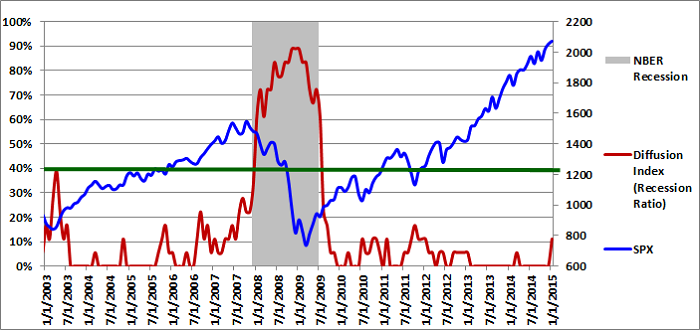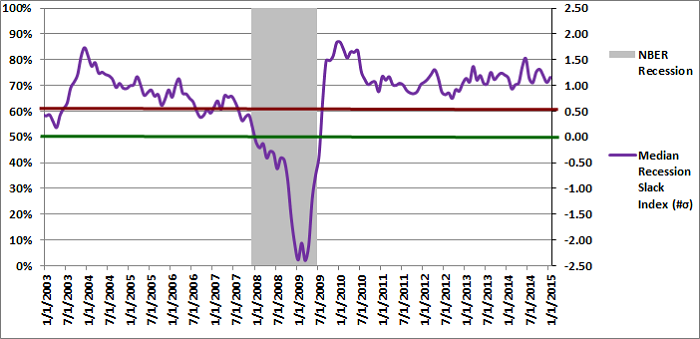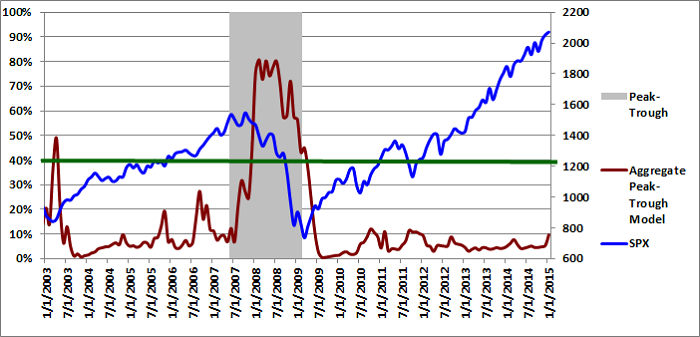The following article updates the diffusion index, recession slack index, aggregate recession model, and aggregate peak-trough model through December 2014. Please note that two new explanatory variables were added to the Trader Edge Recession Models in July and one explanatory variable was replaced in August. The swapped variables measured similar economic data, but the new series had more predictive power and was more forward-looking. For more information on the two new variables, please see "Two New Improvements to Trader Edge Recession Models."
Diffusion Index
The Trader Edge diffusion index equals the percentage of independent variables indicating a recession. With the additions, there are now a total of 18 explanatory variables, each with a unique look-back period and recession threshold. The resulting diffusion index and changes in the diffusion index are used to calculate the probit, logit, and neural network model forecasts.
The graph of the diffusion index from 1/1/2003 to 1/1/2015 is presented in Figure 1 below (in red - left axis). If you would like to view a graph of the earlier historical data (going back to 1960), please revisit A New Recession Slack Indicator. The gray shaded regions in Figure 1 below represent U.S. recessions as defined (after the fact) by the National Bureau of Economic Research (NBER). The value of the S&P 500 index is also included (in blue - right axis).
In December 2014, for the first time since late 2011-early2012, two of the 18 explanatory variables simultaneously indicated a recessionary environment. While the percentage of explanatory variables indicating a recession is still well below past warning levels, a jump from zero to two in a single month is notable. In non-recessionary environments, such weakness tends to persist for a few months and then dissipates. However, if the weakness becomes more widespread or lingers for many months, that would more problematic. The next few months should be very telling.
Please note that past estimates and index values will change whenever the historical data is revised. All current and past forecasts and index calculations are based on the latest revised data.
Recession Slack Index
The Trader Edge recession slack index equals the median standardized deviation of the current value of the explanatory variables from their respective recession thresholds. The resulting value signifies the amount of slack or cushion relative to the recession threshold, expressed in terms of the number of standard deviations.
The gray shaded regions in Figure 2 below represent U.S. recessions as defined (after the fact) by the NBER. The median recession slack index is depicted in purple and is plotted against the right axis, which is expressed as the number of standard deviations above the recession threshold.
The dark-red, horizontal line at 0.50 standard deviations denotes a possible warning threshold for the recession slack index. Many of the past recessions began when the recession slack index crossed below 0.50. Similarly, many of the past recessions ended when the recession slack index crossed back above 0.0.
During the month of December, the recession slack index actually increased from a revised value of 1.06 to 1.16, which was highly unusual given the increase in the number of variables indicating a recession. In other words, the median amount of slack or cushion relative to the recession threshold increased at the same time that the number of variables indicating a recession jumped from zero to two. Since emerging from the great recession, 0.84 (on 9/1/2012) was the lowest recorded value of the recession slack index, so the current value of the recession index (1.16) indicates a much greater recession cushion than we had in the fall of 2012. The recession slack index is well above the warning level of 0.50.
The ability to track small variations and trend changes over time illustrates the advantage of monitoring the continuous recession slack index in addition to the diffusion index above, which moves in discrete steps.
While it is useful to track the actual recession slack index values directly, the values are also used to generate the more intuitive probit and logit probability forecasts.
Aggregate Recession Probability Estimate
The Trader Edge aggregate recession model is the average of four models: the probit and logit models based on the diffusion index and the probit and logit models based on the recession slack index. The aggregate recession model estimates from 1/1/2003 to 01/01/2015 are depicted in Figure 3 below (red line - left vertical axis). The gray shaded regions represent NBER recessions and the blue line reflects the value of the S&P 500 index (right vertical axis). I suggest using a warning threshold of between 30-40% for the aggregate recession model (green horizontal line).
The aggregate recession model probability estimate for 01/01/2014 was 0.3%, which increased by 0.3% from last month's revised estimate of 0.0%. According to the model, the probability that the U.S. is currently in a recession continues to be extremely remote, despite the increase in the diffusion index.
Aggregate Peak-Trough Probability Estimate
The peak-trough model forecasts are different from the recession model. The peak-trough models estimate the probability of the S&P 500 being between the peak and trough associated with an NBER recession. The S&P 500 typically peaks before recessions begin and bottoms out before recessions end. As a result, it is far more difficult for the peak-trough model to fit this data and the model forecasts have larger errors than the recession model.
The Trader Edge aggregate peak-trough model equals the weighted-average of nine different models: the probit and logit models based on the diffusion index, the probit and logit models based on the recession slack index, and five neural network models.
The aggregate peak-trough model estimates from 1/1/2003 to 01/01/2015 are depicted in Figure 4 below, which uses the same format as Figure 3, except that the shaded regions represent the periods between the peaks and troughs associated with NBER recessions. The aggregate peak-trough model probability estimate for 01/01/2015 was 9.7%, which was up materially from the revised value of 5.4% at the end of November. The current peak-trough probability estimate of 9.7% is still well below the early warning threshold of 30% to 40%, but it is the highest value we have seen since late 2011. The highest aggregate peak-trough estimate since the Great Recession was 11.4%, which was recorded on 9/1/2011.
Conclusion
U.S. recession risk remains low, but did increase in December. The diffusion index jumped from zero to two last month. Surprisingly, the recession slack index increased from 1.06 to 1.16 in December. The peak-trough recession probability estimate increased from a revised value of 5.4% in November 2014 to 9.7% at the end of December. All of the forecast values are well inside their respective warning thresholds.
Print and Kindle Versions of Brian Johnson's Book are Now Both Available on Amazon (29 5-Star Reviews)
Trader Edge Strategy E-Subscription Now Available: 20% ROR
The Trader Edge Asset Allocation Rotational (AAR) Strategy is a conservative, long-only, asset allocation strategy that rotates monthly among five large asset classes. The AAR strategy has generated annual returns of approximately 20% over the combined back and forward test period. Please use the above link to learn more about the AAR strategy.
Feedback
Your comments, feedback, and questions are always welcome and appreciated. Please use the comment section at the bottom of this page or send me an email.
Referrals
If you found the information on www.TraderEdge.Net helpful, please pass along the link to your friends and colleagues or share the link with your social or professional networks.
The "Share / Save" button below contains links to all major social and professional networks. If you do not see your network listed, use the down-arrow to access the entire list of networking sites.
Thank you for your support.
Brian Johnson
Copyright 2015 - Trading Insights, LLC - All Rights Reserved.
















